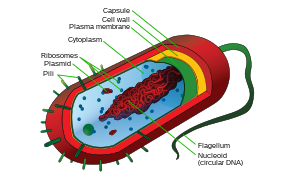Cell theory
In biology, cell theory is a scientific theory that describes the properties of cells, and the basic unit of structure in every living thing. The initial development of the theory, during the mid-17th century, was made possible by advances in microscopy; the study of cells is called cell biology. Cell theory is one of the foundations of biology.
The three parts to the cell theory are as described below:
- All living organisms are composed of one or more cells.
- The cell is the basic unit of structure, function, and organization in all organisms.
- All cells come from pre-existing, living cells.
History
The cell was first discovered by Robert Hooke in 1665. He examined (under a coarse, compound microscope) very thin slices of bottle cork and saw a multitude of tiny pores that he remarked looked like the walled compartments a monk would live in. Because of this association, Hooke called them cells, the name they still bear. However, Hooke did not know their real structure or function. Hooke's description of these cells (which were actually non-living cell walls) was published in Micrographia. His cell observations gave no indication of the nucleus and other organelles found in most living cells.The first person to make a compound microscope was Zacharias Jansen, while the first to witness a live cell under a microscope was Anton van Leeuwenhoek, who in 1674 described the algae Spirogyra and named the moving organisms animalcules, meaning "little animals". Leeuwenhoek probably also saw bacteria. Bacteria are microscopic (very tiny) organisms that are unicellular (made up of a single cell). Cell theory was in contrast to the vitalism theories proposed before the discovery of cells.
The idea that cells were separable into individual units was proposed by Ludolph Christian Treviranus and Johann Jacob Paul Moldenhawer.All of this finally led to Henri Dutrochet formulating one of the fundamental tenets of modern cell theory by declaring that "The cell is the fundamental element of organization".
The observations of Hooke, Leeuwenhoek, Schleiden, Schwann, Virchow, and others led to the development of the cell theory. The cell theory is a widely accepted explanation of the relationship between cells and living things. The cell theory states:
- All living things or organisms are made of cells and their products.
- New cells are created by old cells dividing into two.
- Cells are the basic building units of life.
Credit for developing cell theory is usually given to three scientists: Theodor Schwann, Matthias Jakob Schleiden, and Rudolf Virchow. In 1839, Schwann and Schleiden suggested that cells were the basic unit of life. Their theory accepted the first two tenets of modern cell theory (see next section, below). However, the cell theory of Schleiden differed from modern cell theory in that it proposed a method of spontaneous crystallization that he called "free cell formation". In 1855, Rudolf Virchow concluded that all cells come from pre-existing cells, thus completing the classical cell theory. (Note that the idea that all cells come from pre-existing cells had in fact already been proposed by Robert Remak; it has been suggested that Virchow plagiarised Remak.)
Modern interpretation
The generally accepted parts of modern cell theory include:- All known living things are made up of one or more cells.
- All living cells arise from pre-existing cells by division.
- The cell is the fundamental unit of structure and function in all living organisms.
- The activity of an organism depends on the total activity of independent cells.
- Energy flow (metabolism and biochemistry) occurs within cells.
- Cells contain hereditary information (DNA) which is passed from cell to cell during cell division.
- All cells are basically the same in chemical composition in organisms of similar species.
Types of cells
Cells can be subdivided into the following subcategories:- Prokaryotes: Prokaryotes lack a nucleus (although they do have circular or linear DNA) and other membrane-bound organelles (though they do contain ribosomes). Bacteria and Archaea are two domains of prokaryotes.
- Eukaryotes: Eukaryotes, on the other hand, have distinct nuclei bound by a nuclear membrane and membrane-bound organelles (mitochondria, chloroplasts, lysosomes, rough and smooth endoplasmic reticulum, vacuoles). In addition, they possess organized chromosomes which store genetic material.


No comments:
Post a Comment